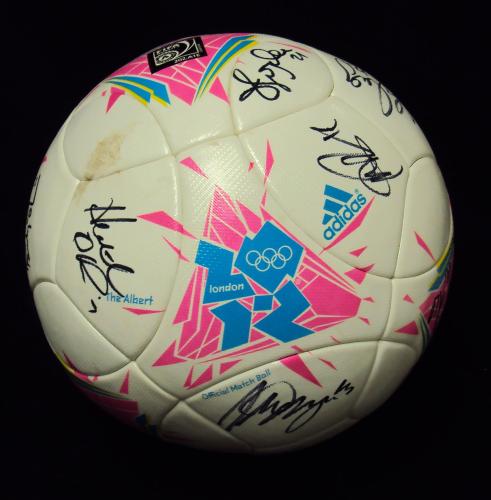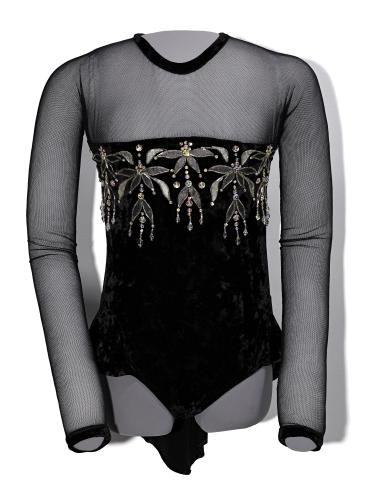
Soccer ball autographed by the 2012 Women’s Olympic Team. Image courtesy of the Division of Culture and the Arts, National Museum of American History.
As a curator of sports and entertainment at the Smithsonian’s National Museum of American History, I often rely on “talking sports” as an icebreaker when meeting members of the public. Sports have a unique power to bring people together—sometimes in surprising ways. Through a partnership with the Smithsonian American Women’s History Museum, I had the opportunity to “talk sports” with actress and activist Rosario Dawson, a member of the Smithsonian American Women’s History Museum Advisory Council. Together, we went behind the scenes to look at artifacts from the museum’s collection representing some of her favorite Olympic memories: a soccer ball used by the United States Women’s National Team at the 2012 Olympics and a skating costume worn by champion figure skater Kristi Yamaguchi. We discussed how these remarkable athletes shaped interests and inspirations and how sports not only help us create our own identities but also reflect the identity of our nation.
Soccer Ball Autographed by the 2012 Women’s Olympic Team
Rosario Dawson views the soccer ball from the 2012 women's Olympic gold medal team - YouTube
The soccer ball Rosario Dawson selected was used in the 2012 London Olympics. The game-used ball was autographed by the star-studded, gold medal winning United States Women’s National Team (USWNT). Featuring international standouts such as Abby Wambach, Carli Lloyd, Megan Rapinoe, and Alex Morgan, the team swept the competition, defeating Japan in the gold medal game 2-1. The championship was the USWNT’s fourth gold medal, continuing a run of success that has not only inspired generations of young women to take up the sport, but has also led to the development of popular professional women’s leagues featuring USWNT members. Many of the team’s players continue to make headlines, using their voices to advocate for women’s rights—not only on the playing field, but in politics and society as well.
Given the USWNT’s current presence as the “gold” standard in women’s team sports, it might be hard to believe that women’s soccer has only been part of the Olympic games since 1996! The world has come a long way since then, with the 2012 games being the first Olympics to have both men’s and women’s events in every sporting category, as well as the first time every competing nation fielded at least one female athlete.
Ice Skating Costume, Worn by Kristi Yamaguchi
Rosario Dawson views Kristi Yamaguchi's costume worn during her “Stars on Ice” tour (youtube.com)
Kristi Yamaguchi’s skating costume was worn when the native Californian participated in “Stars on Ice” tours between 1992–2002. Her participation in the exhibition series followed on the bladed heels of a groundbreaking performance at the 1992 Albertville Olympics, where at the age of 20 she became the first Asian American to win gold at the Winter Games. Yamaguchi’s moment on the podium was the culmination of a stellar amateur career in which she won two World Figure Skating Championships (1991 & 1992) and two U.S. titles in pairs (1989 & 1990) with partner and future men’s singles gold medal winner, Rudy Galindo (Nagano, 1996).
Since the days of three-time gold-medalist Norwegian Sonja Heinie (1927–1936), champions of women’s figure skating often achieved an exalted celebrity status. In winning, Yamaguchi attained instant icon status, being only the third American to win gold in singles following Peggy Fleming (1968) and Dorothy Hammel (1976). Only two others have joined the illustrious group since Yamaguchi’s Albertville triumph: Tara Lipinski (1998) and Sarah Hughes (2002).
It is doubtful that any such goals of Olympic immortality were in Yamaguchi or her parents’ minds when she first laced up her skates as a preschooler. At the time, ice skating was chosen as an activity to help Yamaguchi recover from being born with club foot, a condition that led to her living her earliest days with a cast on her leg.
Having a family member who would become an iconic representation of American success was also likely very far from her grandparent’s minds as well, as they were incarcerated along with over 1,500 other Japanese Americans in internment camps during the Second World War, with Yamaguchi’s mother born in captivity.

Costume worn by American figure skater Kristi Yamaguchi during her “Stars on Ice” tour (1992–2002). Image courtesy of the Division of Culture and the Arts, National Museum of American History, gift from Kristi Yamaguchi.
It was an honor not just to meet Rosario Dawson but to spend time looking at these important artifacts from the history of women’s sports. Our “sports talk” quickly went beyond gold-medal memories to a wider discussion about how sports can impact us not only as individuals, but as a society. We were reminded that women’s participation in athletics, as in all aspects of life, should be celebrated, inspiring and representing Americans of all genders.
As the Olympic games draw our attention again this summer, I look forward to watching the new generation of competitors, wondering what moments will create new shared experiences that can help us connect to one another.
Related Posts
By Eric Jentsch, Curator of Sports and Entertainment at the Smithsonian’s National Museum of American History.